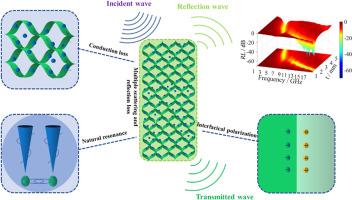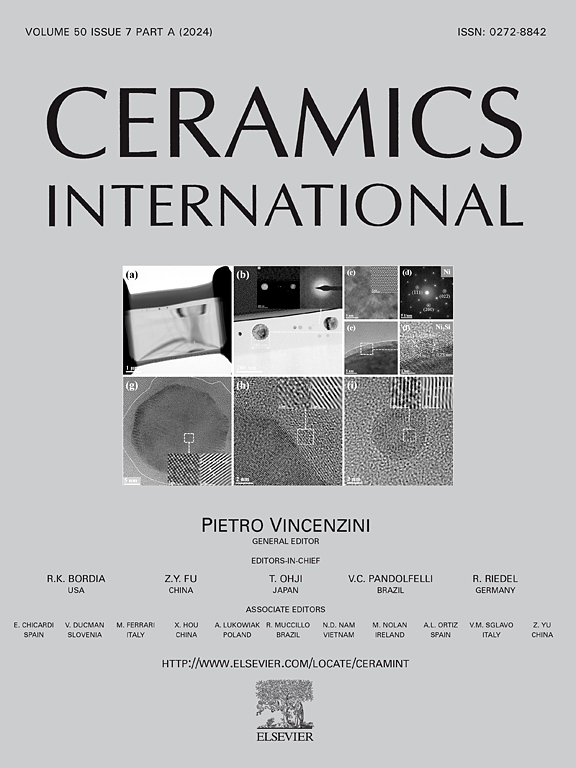Lightweight three-dimensional porous aramid nanofibers/magnetic alloy nanoparticles hybrid aerogel for high-performance microwave absorption
IF 5.1
2区 材料科学
Q1 MATERIALS SCIENCE, CERAMICS
引用次数: 0
Abstract
Low density aerogels based on aramid nanofibers (ANFs) are promising candidate for microwave absorption materials. It is an arduous challenge to obtain lightweight microwave absorption materials with strong reflection loss (RL) and broad effective absorption bandwidth. In this paper, ANFs/FeCo hybrid aerogels were fabricated using ParaPhenylene TerephthalAmide (PPTA) as precursor via two-steps freeze-drying method, which offer three-dimensional network porous structure. ANFs/FeCo aerogel exhibited lightweight characteristic and excellent microwave absorption performance. The ultra-low density (14.35 mg cm−3) of ANFs/FeCo aerogel was lower than the one of CNTs. The improvement of microwave absorption performance of ANFs/FeCo aerogels can be attributed to the three-dimensional network porous structure of aerogels and the introduction of magnetic FeCo alloys nanoparticles which can induce a cooperative effect of proper impedance matching, conduction loss, polarization loss, magnetic loss, and multiple scatting. The RL and effective absorption bandwidth of ANFs/FeCo aerogels can be adjusted via changing the mass ration of ANFs and magnetic FeCo nanoparticles. ANFs/FeCo-3 aerogel exhibited ultra strong RL (−60.62 dB) and broad effective absorption bandwidth (4.8 GHz) under a thin thickness (1.75 mm). Our work can provide new insight into the design of lightweight microwave absorption material.


用于高性能微波吸收的轻质三维多孔芳纶纳米纤维/磁性合金纳米颗粒混合气凝胶
基于芳纶纳米纤维(ANFs)的低密度气凝胶是微波吸收材料的理想候选材料。如何获得具有强反射损耗(RL)和宽有效吸收带宽的轻质微波吸收材料是一项艰巨的挑战。本文以对苯二甲酰对苯二甲酰胺(PPTA)为前驱体,通过两步冻干法制备了ANFs/FeCo混合气凝胶,该气凝胶具有三维网络多孔结构。ANFs/FeCo 气凝胶具有轻质特性和优异的微波吸收性能。ANFs/FeCo 气凝胶的超低密度(14.35 mg cm-3)低于 CNTs。ANFs/FeCo气凝胶微波吸收性能的提高主要得益于气凝胶的三维网络多孔结构和磁性FeCo合金纳米颗粒的引入,这些纳米颗粒可以产生适当的阻抗匹配、传导损耗、极化损耗、磁性损耗和多重散射等协同效应。ANFs/FeCo 气凝胶的 RL 和有效吸收带宽可通过改变 ANFs 和磁性 FeCo 纳米粒子的质量比来调整。ANFs/FeCo-3 气凝胶在厚度较薄(1.75 毫米)的情况下表现出超强的 RL(-60.62 dB)和较宽的有效吸收带宽(4.8 GHz)。我们的研究为轻质微波吸收材料的设计提供了新的思路。
本文章由计算机程序翻译,如有差异,请以英文原文为准。
求助全文
约1分钟内获得全文
求助全文
来源期刊

Ceramics International
工程技术-材料科学:硅酸盐
CiteScore
9.40
自引率
15.40%
发文量
4558
审稿时长
25 days
期刊介绍:
Ceramics International covers the science of advanced ceramic materials. The journal encourages contributions that demonstrate how an understanding of the basic chemical and physical phenomena may direct materials design and stimulate ideas for new or improved processing techniques, in order to obtain materials with desired structural features and properties.
Ceramics International covers oxide and non-oxide ceramics, functional glasses, glass ceramics, amorphous inorganic non-metallic materials (and their combinations with metal and organic materials), in the form of particulates, dense or porous bodies, thin/thick films and laminated, graded and composite structures. Process related topics such as ceramic-ceramic joints or joining ceramics with dissimilar materials, as well as surface finishing and conditioning are also covered. Besides traditional processing techniques, manufacturing routes of interest include innovative procedures benefiting from externally applied stresses, electromagnetic fields and energetic beams, as well as top-down and self-assembly nanotechnology approaches. In addition, the journal welcomes submissions on bio-inspired and bio-enabled materials designs, experimentally validated multi scale modelling and simulation for materials design, and the use of the most advanced chemical and physical characterization techniques of structure, properties and behaviour.
Technologically relevant low-dimensional systems are a particular focus of Ceramics International. These include 0, 1 and 2-D nanomaterials (also covering CNTs, graphene and related materials, and diamond-like carbons), their nanocomposites, as well as nano-hybrids and hierarchical multifunctional nanostructures that might integrate molecular, biological and electronic components.
文献相关原料
公司名称
产品信息
阿拉丁
Iron(III) chloride hexahydrate
 求助内容:
求助内容: 应助结果提醒方式:
应助结果提醒方式:


